Well, here we are. It’s the middle of June and I, along with many Nova Scotians, have been sitting in full or partial lockdown for eight weeks. Since the last week of April, I have only left my apartment a handful of times for essential purposes, as my wife has been handling all of our business packages and essential shopping in compliance with Nova Scotia’s lockdown restrictions. Fortunately, the light is at the end of the tunnel, the third wave is nearly crushed and in a couple of days I will legally be allowed to leave my home for non-essential reasons for the first time in nearly two months.
Many Canadians have gone through this at one time or another over the past fifteen months and it has affected us all differently. For me, entering lockdown started with lofty goals of completing myriad household, business, and research projects. Yet, as the days turned into weeks and various projects were usurped by distractions and other priorities (like trying to buy a house), I find myself with a bunch of lockdown loose ends in all facets of my life, including my comic book research. So, this month’s column will be a little bit different. Rather than focusing on a specific topic or providing a detailed analysis of a particular creator or series, this month I want to highlight a bunch of disparate subjects that are not expansive enough to justify an entire column, but help to flesh out some topics I have covered previously here, along with some current news.
Versatile Canadian actor, Paul Soles, died on May 26 in Toronto. He was arguably best known as the voice of Hermey in the 1964 stop-motion animated film Rudolph the Red-Nosed Reindeer and as the voice of Spider-Man in the 1967 cartoon series (which was co-produced in Canada). He was also the voice of Bruce Banner in the 1966 cartoon series The Marvel Super Heroes and made a cameo in the MCU movie The Incredible Hulk in 2008. I mentioned Mr. Soles and provided a brief overview of the history of Krantz Films a year ago in my overview of Gamut and Sheridan College. In addition to his voice acting work, Mr. Soles was an accomplished thespian, occasional television host and documentary producer. He continued to act into his late 80s, winning a Canadian Screen Award for his role as a recently widowed grandfather in My 90-Year Old Roommate. Rest in Peace, Mr. Soles.
Jim Mickle’s adaptation of Jeff Lemire’s Sweet Tooth launched on Netflix on June 4. The television series is radically (or should I say “wildly”) different from the source material. Whereas Lemire’s original 2009 comic series is incredibly bleak, there is something about the Netflix series that much more pleasant and hopeful in its presentation. Fans of the Vertigo comic series may be disappointed by how loose the adaptation is: there are several new characters and significant alterations to the characters who make the leap to the screen from the comics. That said, audiences who are not familiar with the source material will find a television series that is heartfelt and strangely resonates in our (hopefully soon-to-be) post-COVID world.
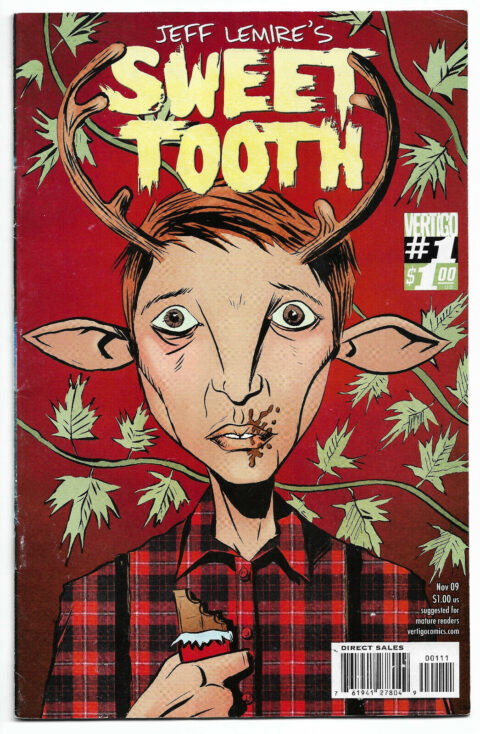
It is not often that an independent Canadian created comic series gets made for television (be it a live action or animated adaptation). The most recent adaptations I can think of are Dark Matter, which was cancelled on a cliffhanger and the Captain Canuck animated series. Here’s hoping for a second season of Sweet Tooth.
The revelations that came out of Kamloops at the end of May have reopened the wounds of the residential school system in Canada and laid bare the reality that deniers can no longer escape from. As a result, I spent some time during the first week of June revisiting Lemire and Gord Downie’s 2016 collaboration, Secret Path. The multimedia project is an account of the tragedy of Chanie Wenjack trying to walk home to Marten Falls First Nation after escaping a residential school in 1966. Wenjack died from starvation and exposure trying to walk home. Wenjack’s death led to an inquest in the 1960s, which didn’t lead to significant change. Fifty years later, Downie made reconciliation his mission as he died from brain cancer.
Towards the end of 2016, Downie announced that he was touring Canada to promote his solo album and the animated film accompanying it (based on Lemire’s artwork). Proceeds would go to the Chanie Wenjack Foundation. Downie performed at Halifax’s Rebecca Cohn auditorium on November 29 and Jeff Lemire came to Halifax as part of the tour.

The concert was, from what I understand, extremely well-received. The ticket sales, however, were marred by glitches and scalpers scooping up many of the passes. Few people who stood in line in person were able to purchase tickets and the website crashed almost immediately after going live. Instantly, tickets appeared on Stubhub and Kijiji for outrageous prices. I was part of a group of people who, independently of each other, put enough pressure on eBay (who owned Stubhub and Kijiji at the time) to ban the resale of Secret Path Tour tickets on their websites. I even appeared on CBC’s Mainstreet to discuss the issue.
The famed comic shop, Strange Adventures, hosted a signing with Jeff Lemire the same day that Downie performed in Halifax and I was at the front of the line. Nearly five years later, the revelations from Kamloops and the unimaginable pain being re-experienced by members of Tk’emlúps te Secwépemc First Nations (and indigenous people across this country) is now our national shame. Rightly so.
Almost two years ago, I published one of my favourite columns here at Comic Book Daily, which focused on comics from the great white north and issues of indigenous representation. Only one person commented on that month’s article and I am not sure how well it was received by regular readers. The reality is that, with the exception of the work of Nick Burns (such as Super Shamou), comics depicting indigenous people in Canada during the Canadian Silver Age were problematic at best, while more often than not being outright racist and culturally damaging. I returned to this topic, albeit briefly, when discussing environmental giveaway comics from the 1960s last year.
Despite this, there were a small number of indigenous Canadian comic creators during the era. Perhaps the best known is Frank McTruck of FreeKluck fame. Another is well-known Richmond, BC-based fine artist Dan Daulby, who published two issues of his comic The Great Canadian Shimegly Follies in Winnipeg in the 1970s. Interestingly, McTruck and Daulby’s comic creations were heavily indebted to the underground comix movement and do not examine issues of indigenous identity. The only comics from the Canadian Silver Age that I know of that deal with issues of indigenous identity (and also act as examples of activism) from the era are the two issues of Tales of Raven by Michael Nicoll Yahgulanaas and John Broadhead from Haida Gwaii. I discussed these comics last year.
One of the benefits of writing this column is that readers sometimes reach out to me with additional information about a topic I have covered. In rare instances, someone will contact me about a comic I have never heard of. This happened last year after my discussion of environmental comics, when collector John Richardson contacted me about a comic called Clayoquot Days that was released in Victoria, BC, by Bush Pyramid Press. Although the comic is undated, it was likely published in 1993 or 1994. The comic is similar stylistically to the underground environmental comics I covered from the 1970s and 1980s. Despite being an early Modern Age comic, Clayoquot Days has the look and feel of a late Canadian Silver Age comic. Attached are some of the images that Mr. Richardson shared with me.
Dan, Victor and I spent a bit of time trying to learn more about the comic, but were unable to identify the creators. Nevertheless, the comic’s title should be recognizable to Canadians: the 1993 Clayoquot protests (also known as the “War in the Woods”) remains the largest act of civil disobedience in Canadian history, culminating wit the arrest of approximately 900 people.
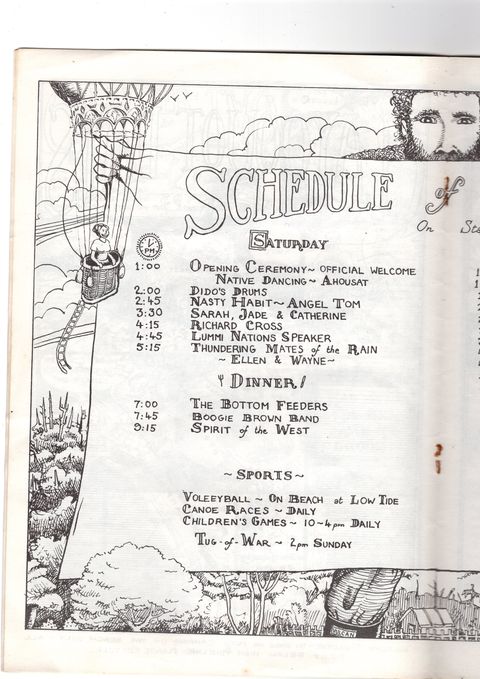
Residents of Clayoquot Sound (located on western Vancouver Island) had been engaging in protests and blockades against the lumber industry since the early-1980s. The timber resources in the region had attracted a sizeable amount of foreign investment and resource extraction at the expense of the local indigenous population. Indeed, three major First Nations band governments of Nuu-chah-nulth peoples inhabit the area.
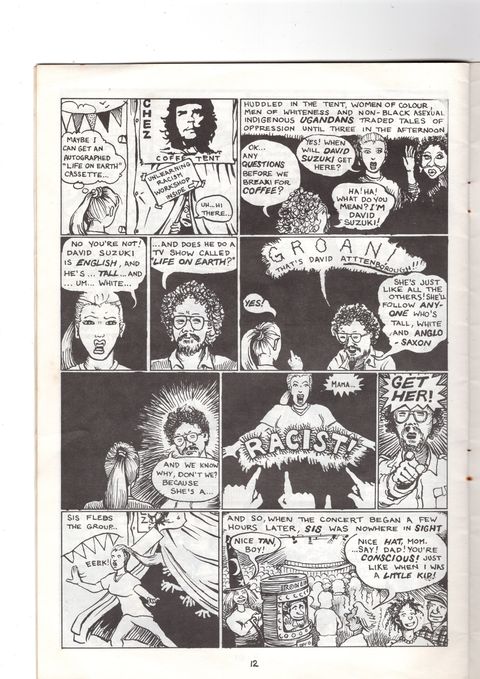
The War in the Woods became an international incident, attracting media and celebrity attention and had a long-lasting effect on environmental policy in BC. The comic book that Mr. Richardson shared with us serves as both a program for and fictional account of a protest concert (featuring Spirit of the West and the Boogie Brown Band) that occurred in either 1993 or 1994. The comic also features what I believe to be the first appearance of Dr. David Suzuki in a comic book. Thank you, Mr. Richardson, for reaching out and sending me this information.
Another collector and Forgotten Silver reader who reached out to me recently is Ben Benoit. Mr. Benoit contacted me earlier this year concerning Captain Newfoundland. Long time readers of this column will remember that I wrote a two-part treatment of Captain Newfoundland and Captain Canada in early 2019. Mr. Benoit was hoping that I knew whether or not Geoff and Scott Stirling had created more than the three comics that they had released. When I originally covered the characters, I mentioned that there were rumours of a third issue called The Legend of Captain Atlantis, which was supposedly published in 1989. Thanks to Mr. Benoit, we now know that the comic does indeed exist, as he shared the cover of his copy with me.
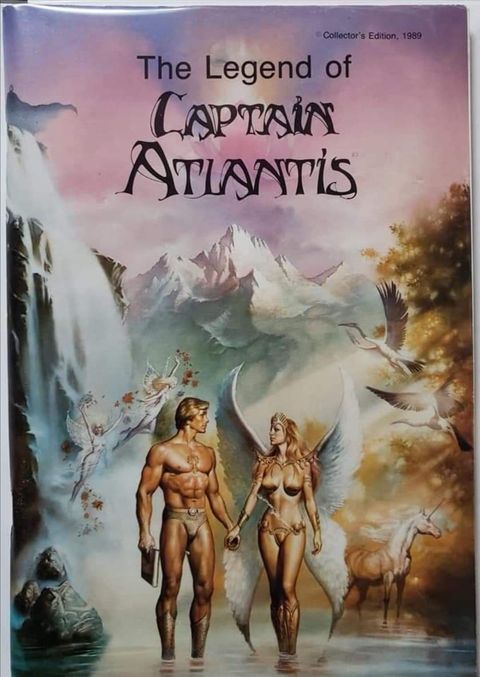
Other researchers often reach out to me too. This happened serendipitously last year when Jason Vanderhill messaged me out of the blue when I was compiling information to write my column about environmental giveaway comics. Mr. Vanderhill shared some rare cover preliims of Fraser Wilson’s Bill Northwood comic at that time and was able to provide me with a specimen of the English version of the comic for my archives. Mr. Vanderhill’s blog Illustrated Vancouver is one of my favourite pieces of Canadiana and I highly recommend it. He messaged me recently to let me know that he has just published a new book called Consairway Flight Deck Comics, which provides a detailed look at comics published for air travellers flying with the company from 1943-45. Although Consairway was an American company, he also informed me that he is starting to compile resources regarding Canadian in-flight comics from the same era.
After my column last month about the sizeable number of early Barry Blair Nightwynd comics coming to market (and in some cases achieving record sales), collector Doug Tomey contacted me and we had a great discussion about Blair’s early work. A longtime Nightwynd collector, Mr. Tomey shared a few covers of early Nightwynd comics with me that I had not previously seen, including covers for three issues of Elflord and one issue of Samurai. I have now seen covers for all issues of the two series. Unfortunately, Mr. Tomey did not have images of the rare Dragonring or Tower of Blood one-shots that Blair released prior to Aircel. These two comics have achieved unicorn status for me. Hopefully, one (or both) will come to market soon so that Dan, Victor and I (as well as collectors like Mr. Tomey) can finally learn more about these illusive comics.
Some of the covers that Mr. Tomey shared with me are too rough to reprint here, but attached are two of the Elflord covers he provided. Thanks again, Doug!
After the incredible number of rare Nightwynd comics were sold this spring, it has been relatively slow in terms of unusual Canadian Silver Age books coming to market. Two auctions that I think are quite interesting did end at the end of April and beginning of May that I think are worth delving into.
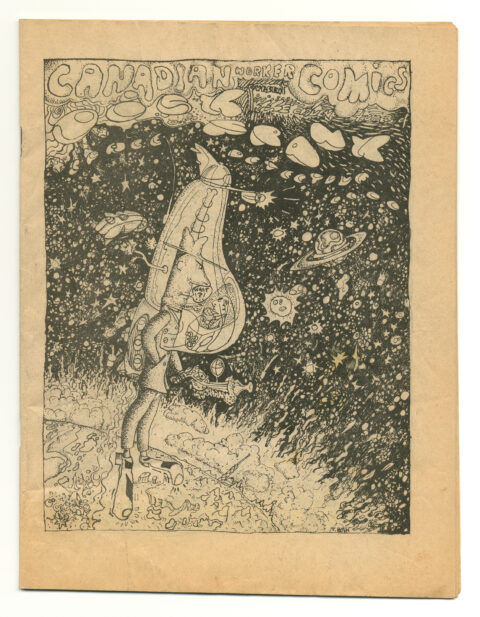
On April 28, a copy of Canadian Worker Comics sold for $32.66 USD. I know that some Forgotten Silver readers were paying attention to this one. Our research group was keeping a close eye on this too, as Victor had identified this comic several years ago and we only had a poor-quality cover scan in any of our files. This is the first time that we have ever seen this book come to market. It is fitting, then, that Victor won the auction. After he received the comic, he shared several images with Dan and me.
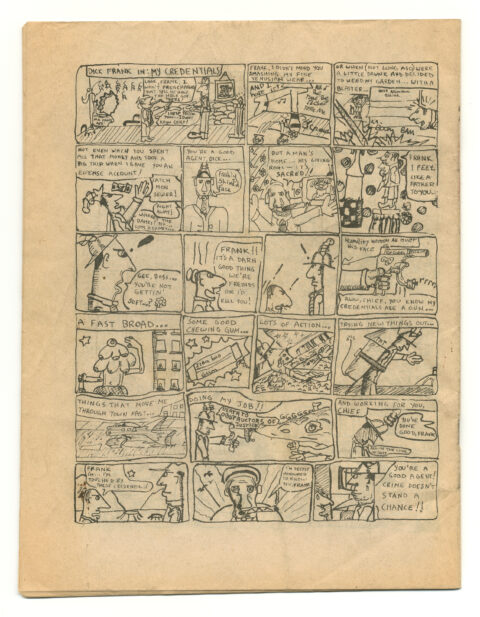
The 32-page comic measures 7-3/4″ x 10-1/8″ and its full title is, Canadian Work Comics Present the Adventures of Dick Frank Space Detective. There is no indicia and the creator only signs their name as “T. Ban” or “T. Brn” on the front cover. The comic is undated, though we assume it is from the mid-1980s, based on the toning of the newsprint. The artwork is crude and only one page of the comic deviates from the Dick Frank story, which is called “Pete ‘n’ Zappa Funnies.” This is, presumably, an in-joke about someone the creator knew. For now, we have more questions than answers about this comic. If you know something we don’t, please contact me.
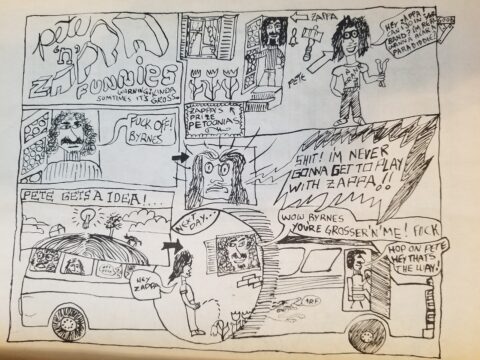
The other interesting eBay auction ended on May 6 and was a lot of original Chester Brown Yummy Fur mini comics (issues # 1, 2, 3, 5, 6 and 7). The lot was made up entirely of later printings and sold for $121.00 USD. Of note is that the only missing issue (issue # 4) tends to be the issue that is missing from collections when they come to market. This could be a mere coincidence, but I am beginning to suspect that issue # 4 may be the hardest to find of the bunch.
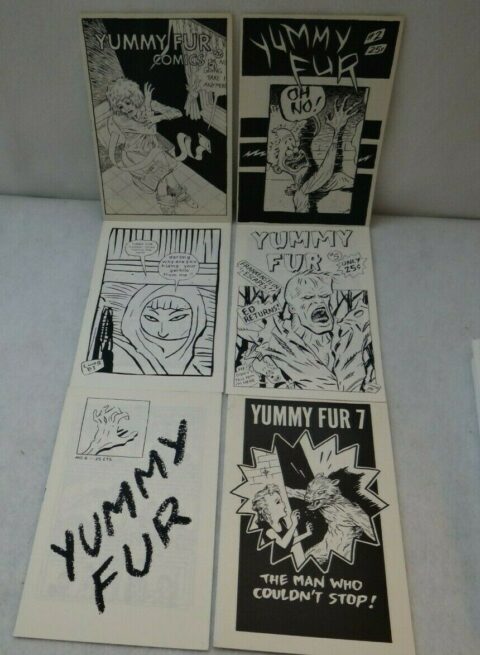
The last collection of Yummy Fur minis that I remember coming to market was at least a couple of years ago and sold for a similar amount. Had this collection included any first printings, this would have been a steal. As it is, I think that the final price was a fair one for both the buyer and the seller.
A couple of years ago, I wrote a column about how to identify whether or not a copy of Cerebus #1 is a counterfeit using information that Dan Bryantowich and I had compiled. At the time, collecting Cerebus had stagnated due to a variety of factors, including negative press that creator Dave Sim had received. Fast forward to June, 2020, when an Indiegogo campaign raised over $60,000 USD to reprint the comic. This was followed by another Indiegogo campaign to reprint Spawn #10 raising over $118,000 USD last November. Less than two years after my column about the caveats of collecting Cerebus # 1, early issues of Cerebus are achieving record prices, with issue #1 leading the way.
Things started heating up late last year when authentic raw mid-grade specimens of issue #1 stated to dry up. At the same time, the dreaded counterfeits were starting to increase in value too. In February of this year, Comic Link auction a CGC 9.4 specimen. This is the highest grade for an unsigned example of the comic and there are only two copies in grade. Note that there are an additional three CGC signature series specimens in 9.4 and a lone signature series specimen in 9.6. The copy in question sold for $29,130 USD, the highest price ever achieved for the comic.
The last time that any CGC 9.4 copies of Cerebus #1 came to auction was in 2014. One of the copies was a signature series specimen that was auctioned by Sim at Toronto Comicon to support A.C.T.O.R. (A Commitment to Our Roots) and sold for $10,600 USD. Apparently one of the other specimens sold for approximately $9,000 USD towards the end of 2014. I am not sure what the third CGC 9.4 copy sold for that year. Nevertheless, this is quite the jump in a seven-year span.
Raw copies of Cerebus #1 have also achieved incredible numbers recently. On April 30, a mid-grade example sold for $1,700 USD on eBay. Less than a month later, a slightly better-looking example sold for $2,200 USD on May 22. On May 26, the best-looking raw example of the comic I have ever seen sold for $5,900 USD.
If you have a copy, now might be the time to sell. On the other hand, if you are looking to get into Cerebus you may have a hard time finding an authentic issue #1 for a reasonable price. For the first time in a long time there are no copies available for sale that I am aware of. Issues #3 and #4 are also experiencing major increases (they are the first appearances of Red Sophia and Elrod, respectively).
One final loose end: Big B Comics is selling a large number of Canadian Whites/WECA comics on eBay from June 18-28. You will be able to see the comics at Big B’s eBay store. More details are available here. As explained by Ivan Kocmarek:
Proceeds from the auction will go towards helping fund 80th Anniversary of Canadian Comic Books projects such as the reprint of Better Comics No. 1. More than two dozen war time Canadian comics have been donated including items such as Super Comics Vol. 2 No. 6, Canadian Heroes Vol. 1 No. 5, Triumph Comics No. 23, Commando Comics No. 11, and Triumph-Adventure Comics No. 4 (coverless) with more items coming in. There will also be a number of Anglo-American books, both black-and-white and in colour as well as a good number of reprint era books, including a handful of Canadian EC reprints. Get the word out! Get ready to bid on these hard to find Canadian golden age books.
As a final note: Forgotten Silver readers often ask in the comments section for a way to contact me privately. I am particularly skittish about giving out my email address on a public forum and I kindly ask that people do not contact me through eBay. That said, you can reach me at our Facebook business page (@eastcoasttoysandgames) and you can also contact me through the CGC forums. I don’t post there often anymore, but I am still lurking around.
Well, that was a lot of loose ends. All tied up! Next month, I will return to something that is a bit more familiar stylistically.

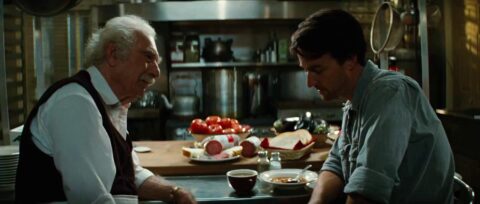
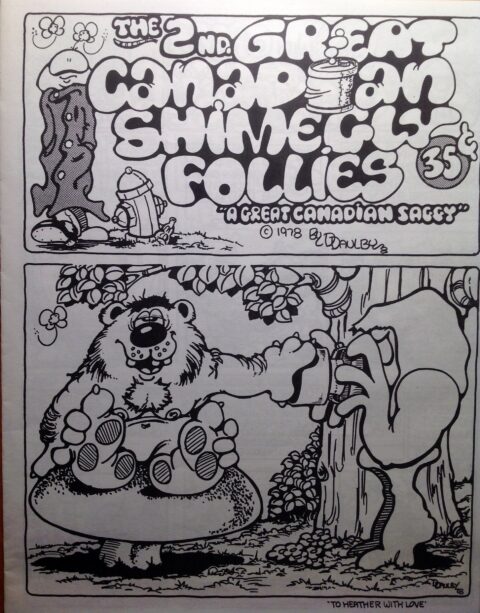
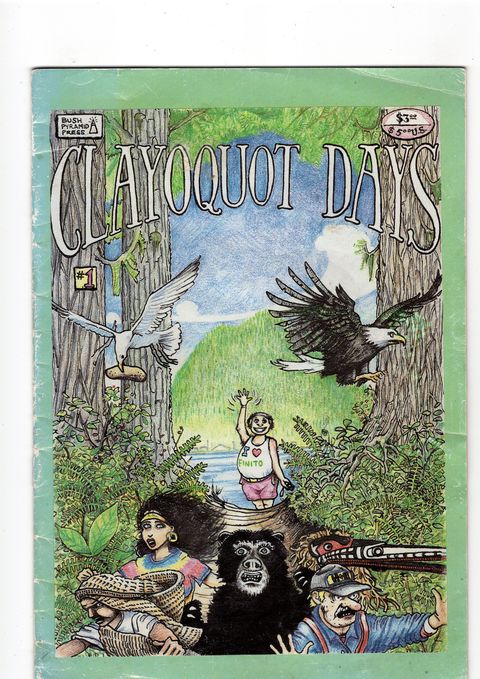
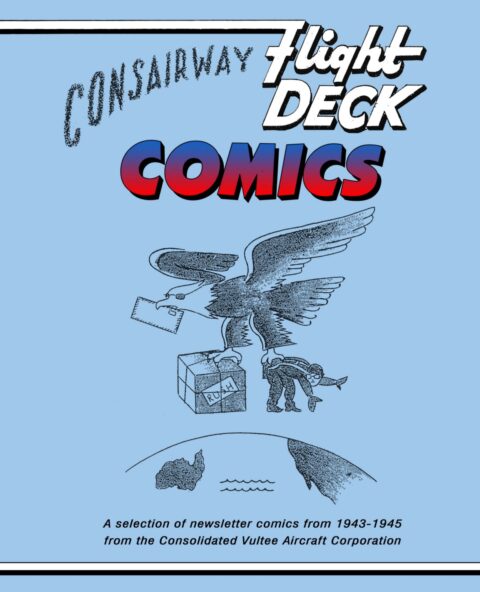
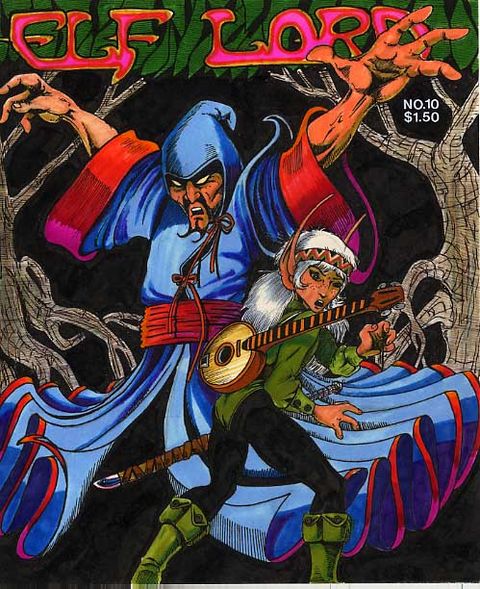
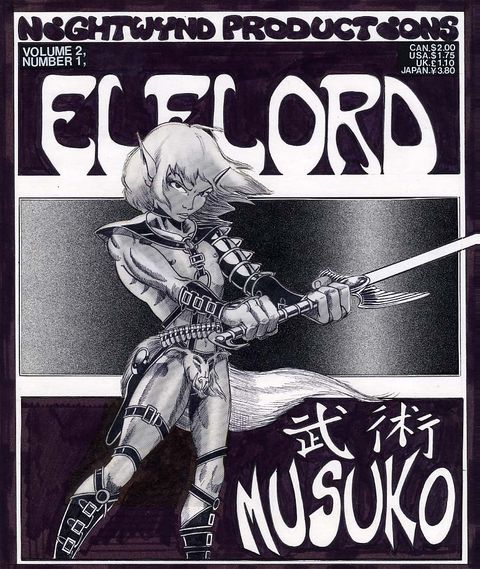
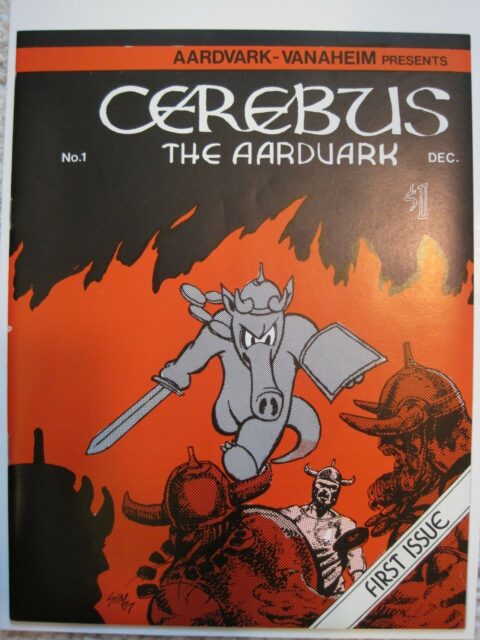
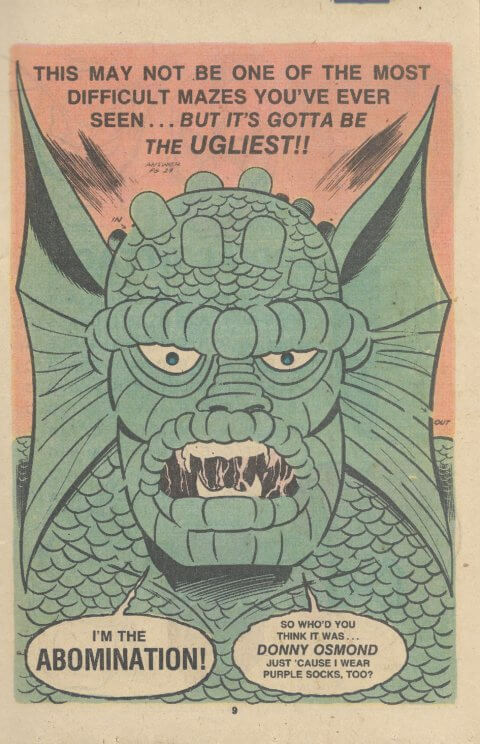
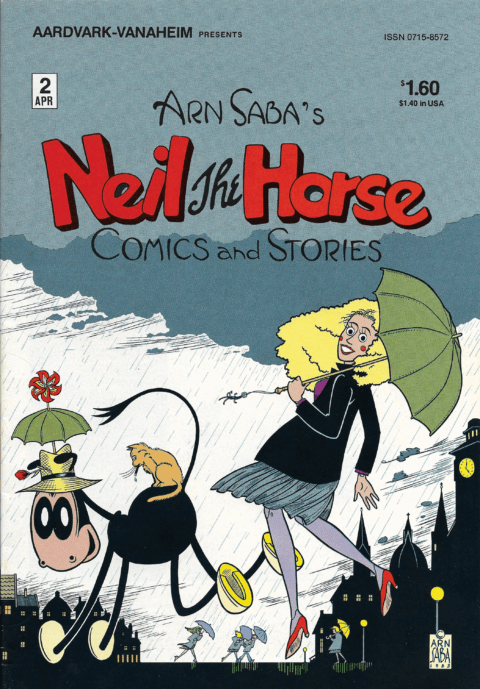
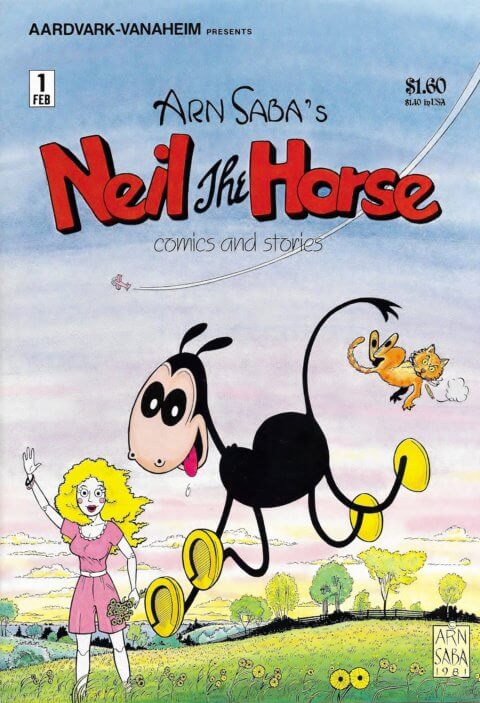
Fabulous loose ends, Brian. I never knew Canadian Comics was so active and it’s great to read about them in your articles, makes me want to start looking for them. That IS a Boris cover on a Canadian comic, some kind of story there considering his fame. I think I like the pre-Aircel Barry Blair art a bit more than the Aircel era*. And once upon a time I did have an original Cerebus #1, plus…now very : (
Time to reread Cerebus so I’ll have to start tracking down the trade paperbacks and such.
A friend whom I’ve never met and who sells comics on eBay has quite a few Aircel issues for anybody looking for them. His handle is Zelascomics and he’s in Kelowna.
Lots of good info, thanks!
–Rick
Thanks for your comments, Tim and Rick! Always appreciate it. I am quite certain that the “Legend of Atlantis” cover is by Vallejo, especially considering that he did the cover for the second volume of the series, as well as several covers for the “Newfoundland Herald.” Since I have not verified this in person, I was a bit wishy-washy about it above.
My wife has an authentic copy of Cerebus # 1, she isn’t interested in selling. We discussed selling it last year. I’m glad she decided to hold on to it. For anyone who wants to read the series, the graphic novel route is always an option.
There is definitely something appealing about Blair’s early Nightwynd stuff. Perhaps it is the fact that the artwork is so good for an amateur. There are a lot of gems among the comics Aircel published. The good thing for people looking to collect this stuff is that Aircel comics continue to be inexpensive and underappreciated. Thanks for sharing that your in Kelowna has Aircel books for sale.